The gunman in two campus attacks that claimed 33 lives, including his own, at Virginia Tech University was a South Korean citizen and a fourth-year student in the university's English department, school officials said at a press conference yesterday.
Virginia Tech police chief Wendell Flinchum identified the gunman as Cho Seung-hui, 23.
Flinchum also said the same gun was used at both shooting sites, but he would not rule out the existence of "accomplices."
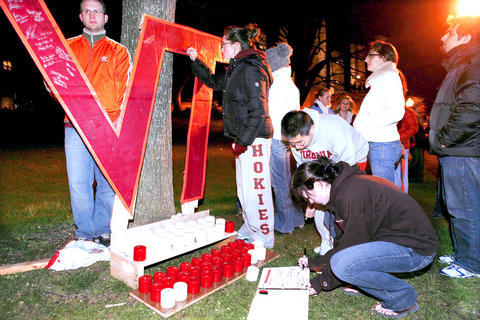
PHOTO: EPA
However, there was no evidence presented that there was a second gunman involved.
"It's certainly reasonable to assume that Cho was the shooter in both cases,'' but authorities have not made the link for sure, said Colonel Steve Flaherty, superintendent of the Virginia State Police.
No motive for the shootings has been given.
Cho was a permanent resident of the US and his identity was confirmed with a positive fingerprint match on the guns used in the rampage and with US immigration materials, ABC News reported on its Web site, without identifying its sources.
He lived on the school campus.
The gunman struck down two people at a dormitory on Monday before killing 30 more people in four different classrooms and in a stairwell of a campus building and finally killing himself with a shot to his head in one of the classrooms.
University president Charles Steger said yesterday that classes had been canceled for the rest of the week. He also announced that the classroom building, Norris Hall, would be closed for the remainder of the semester.
Steger also defended the school's delay in warning students about what became the deadliest shooting rampage in US history.
Some students said their first warning came more than two hours after the first shooting, in an e-mail at 9:26am. By then the second shooting had begun.
"I think the university has blood on their hands because of their lack of action after the first incident," said Billy Bason, 18, who lives on the seventh floor of West Ambler Johnston, the high-rise coed dormitory where the shooting spree began.
Steger said the university was trying to notify students who were already on-campus, not those who were commuting in.
"We warned the students that we thought were immediately impacted," he told CNN. "We felt that confining them to the classroom was how to keep them safest."
He said investigators did not know there was a shooter loose on campus in the interval between the two shootings because the first could have been a murder-suicide.
Two students told NBC TV's Today show they were unaware of the dorm shooting when they reported to a German class where the gunman later opened fire.
Derek O'Dell, his arm in a cast after being shot, described a shooter who fired away in "eerily silence" with "no specific target -- just taking out anybody he could."
After the gunman left the room, students could hear him shooting other people down the hall. O'Dell said he and other students barricaded the door so the shooter couldn't get back in -- though he later tried.
"After he couldn't get the door open he tried shooting it open ... but the gunshots were blunted by the door," O'Dell said.
President George W. Bush and first lady Laura Bush were planning to attend a 2pm convocation yesterday, and people sought comfort on Monday night at a church service on the campus.
The shooting began about 7:15am on the dorm's fourth floor.
Police were still investigating around 9:15am, when a gunman wielding two handguns and carrying multiple clips of ammunition stormed Norris Hall, a classroom building 0.8km away on the 1,052 hectare campus.
At least 15 people were hurt in the second attack, some seriously. Many found themselves trapped after someone, apparently the shooter, chained and locked Norris Hall doors from the inside.
Students jumped from windows, and students and faculty carried away some of the wounded.
Police commandos swarmed over the campus. A student used his cell-phone camera to record the sound of bullets echoing through a stone building.
Inside Norris, the attack began with a thunderous sound from Room 206 -- "what sounded like an enormous hammer," said Alec Calhoun, a 20-year-old junior who was in a solid mechanics lecture in a classroom next door.
Screams followed an instant later, and the banging continued. When students realized the sounds were gunshots, Calhoun said, he started flipping over desks to make hiding places.
Others dashed to the windows of the second-floor classroom, kicking out the screens and jumping from the ledge of Room 204, he said.
"I must've been the eighth or ninth person who jumped, and I think I was the last," Calhoun said.
He landed in a bush and ran.
Calhoun said that the two students behind him were shot, but that he believed they survived. Just before he climbed out the window, Calhoun said, he turned to look at his professor, who had stayed behind, apparently to prevent the gunman from opening the door.
The instructor was killed, Calhoun said.
Erin Sheehan, who was in the German class next door to Calhoun's class, told the student newspaper, the Collegiate Times, that she was one of only four of about two dozen people in the class to walk out of the room. The rest were dead or wounded, she said.
She said the gunman "was just a normal-looking kid, Asian, but he had on a Boy Scout-type outfit. He wore a tan button-up vest, and this black vest, maybe it was for ammo or something."
The gunman first shot the professor in the head and then fired on the class, another student, Trey Perkins, told the Washington Post.
The gunman was about 19 years old and had a "very serious but very calm look on his face," he said.
"Everyone hit the floor at that moment," said Perkins, a second year student studying mechanical engineering. "And the shots seemed like it lasted forever."
At an evening news conference, Police Chief Wendell Flinchum refused to dismiss the possibility that a co-conspirator or second shooter was involved. He said police had interviewed a male who was a "person of interest" in the dorm shooting and who knew one of the victims, but he declined to give details.
Steger said authorities believed the shooting at the dorm was a domestic dispute and mistakenly thought the gunman had fled the campus.
"We had no reason to suspect any other incident was going to occur," he said.
Steger emphasized that the university closed off the dorm after the first attack and decided to rely on e-mail and other electronic means to spread the word, but said that with 11,000 people driving onto campus first thing in the morning, it was difficult to get the word out.
He said that before the e-mail was sent, the university began telephoning resident advisers in the dorms and sent people to knock on doors. Students were warned to stay inside and away from the windows.
"We can only make decisions based on the information you had at the time. You don't have hours to reflect on it," Steger said.
The 9:26 e-mail had few details:
"A shooting incident occurred at West Amber Johnston earlier this morning. Police are on the scene and are investigating." The message warned students to be cautious and contact police about anything suspicious.
Until Monday, the deadliest shooting in modern US history was in Killeen, Texas, in 1991, when George Hennard plowed his pickup truck into a Luby's Cafeteria and shot 23 people to death, then himself.
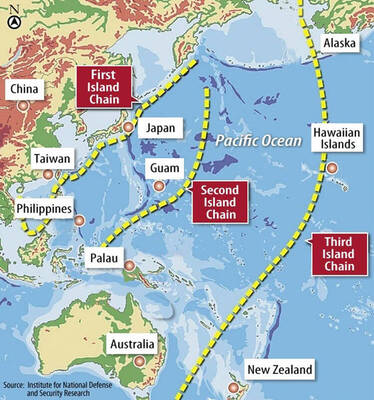
The US government has signed defense cooperation agreements with Japan and the Philippines to boost the deterrence capabilities of countries in the first island chain, a report by the National Security Bureau (NSB) showed. The main countries on the first island chain include the two nations and Taiwan. The bureau is to present the report at a meeting of the legislature’s Foreign Affairs and National Defense Committee tomorrow. The US military has deployed Typhon missile systems to Japan’s Yamaguchi Prefecture and Zambales province in the Philippines during their joint military exercises. It has also installed NMESIS anti-ship systems in Japan’s Okinawa
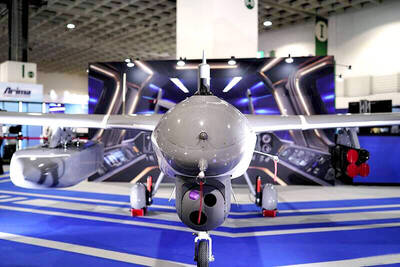
‘WIN-WIN’: The Philippines, and central and eastern European countries are important potential drone cooperation partners, Minister of Foreign Affairs Lin Chia-lung said Minister of Foreign Affairs Lin Chia-lung (林佳龍) in an interview published yesterday confirmed that there are joint ventures between Taiwan and Poland in the drone industry. Lin made the remark in an exclusive interview with the Chinese-language Liberty Times (the Taipei Times’ sister paper). The government-backed Taiwan Excellence Drone International Business Opportunities Alliance and the Polish Chamber of Unmanned Systems on Wednesday last week signed a memorandum of understanding in Poland to develop a “non-China” supply chain for drones and work together on key technologies. Asked if Taiwan prioritized Poland among central and eastern European countries in drone collaboration, Lin
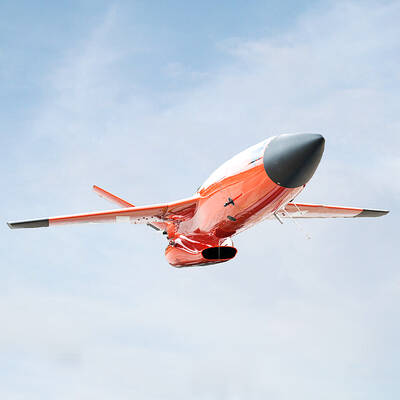
The Chien Feng IV (勁蜂, Mighty Hornet) loitering munition is on track to enter flight tests next month in connection with potential adoption by Taiwanese and US armed forces, a government source said yesterday. The kamikaze drone, which boasts a range of 1,000km, debuted at the Taipei Aerospace and Defense Technology Exhibition in September, the official said on condition of anonymity. The Chungshan Institute of Science and Technology and US-based Kratos Defense jointly developed the platform by leveraging the engine and airframe of the latter’s MQM-178 Firejet target drone, they said. The uncrewed aerial vehicle is designed to utilize an artificial intelligence computer
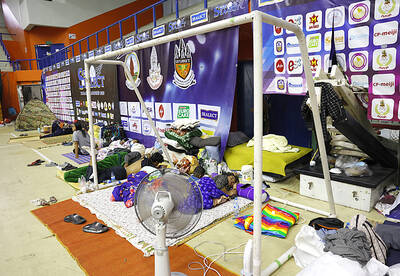
Renewed border fighting between Thailand and Cambodia showed no signs of abating yesterday, leaving hundreds of thousands of displaced people in both countries living in strained conditions as more flooded into temporary shelters. Reporters on the Thai side of the border heard sounds of outgoing, indirect fire yesterday. About 400,000 people have been evacuated from affected areas in Thailand and about 700 schools closed while fighting was ongoing in four border provinces, said Thai Rear Admiral Surasant Kongsiri, a spokesman for the military. Cambodia evacuated more than 127,000 villagers and closed hundreds of schools, the Thai Ministry of Defense said. Thailand’s military announced that